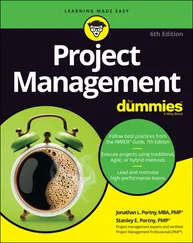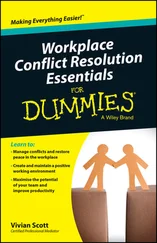✓ You can sketch out the idea for the project and get agreement before going on to full planning.If you leap straight in to full planning, you often discover that disagreement arises when people check the plans, because they have different ideas about the project even though they’re using the same words.
In the Starting the Project stage, you need to go fast. A common mistake is confusing Starting the Project with the next stage, Organising and Preparing, which takes a while. The Starting the Project stage need only take up a couple of days or maybe just a few hours of your time, even if the project is fairly substantial.
In the Starting the Project stage, you consider roughly what the project is and whether it’s worth continuing to the next stage to do the full planning. You look at six key areas:
✓ Objective:What exactly is the objective of the project? To save money perhaps, or speed up ordering procedures? You need to ensure your objective(s) are clear, so that the project can be agreed on.
✓ Scope:What’s the project intended to cover and, usefully, what won’t it cover if some areas are unclear? What will the project finally deliver?
✓ Resource:How much do you expect the project to cost? Be realistic here. How much staff resource will the project need, and will it require particular skills? The resource figures are very much ballpark ones at the moment because the planning has yet to be done.
✓ Time:How long is the project likely to take, on the assumption that resources can be provided when needed? Again, this is a ballpark estimate.
✓ Justification:Why do you want to run the project? Perhaps this is a no-brainer because the project is mandatory – head office has instructed that each regional office runs a project to review its local client base. Normally, though, the project is justified because of benefits, such as greater market penetration, lower costs or faster customer service.
✓ Constraints:Will anything influence the way that the project is run, or even what it delivers and when? For example, it might be time critical. You should also think about the required quality level of the project, such as whether it’s ‘quick and dirty’, safety critical or, usually, somewhere in between.
To document the Starting the Project stage you put the information you find out in a Project Outline that others (such as steering committee members) can read and then approve or reject. However, don’t get too detailed. Although the information is in a document, you might discuss the content in a meeting or give a short presentation to the decision-makers and hand out the document as a backup.
Organising and preparing
Ah, so the members of the steering committee loved the idea, did they? Well done on your presentation of the Project Outline. Okay, on with the next stage then: Roll up your sleeves and get down to the real work of project planning.
The Organising and Preparing stage gets you ready for the delivery stages of the project. It covers the overall planning of the project and also the detailed planning of the first delivery stage. If the sponsor or steering committee says ‘go’ at the end of the Organising and Preparing stage, the first delivery stage can start immediately, because the detailed plan for it is already in place.
 When thinking through this stage, balance the work very carefully. A major cause of project failure is poor plans or a complete lack of plans. However, the answer to that problem isn’t to go to the other extreme of developing excessively detailed plans for everything. Over-planning just wastes time now, and then again as the plans are maintained throughout the project. Remember to provide sufficient information to define and control the project, but not more than that.
When thinking through this stage, balance the work very carefully. A major cause of project failure is poor plans or a complete lack of plans. However, the answer to that problem isn’t to go to the other extreme of developing excessively detailed plans for everything. Over-planning just wastes time now, and then again as the plans are maintained throughout the project. Remember to provide sufficient information to define and control the project, but not more than that.
Developing a high-level plan first, then a more detailed Stage Plan as you approach each delivery stage, gives you good control over a project. Start simple and only get complicated where really necessary in order to provide sufficient checks and direction over the project.
Knowing what’s ahead
For the detailed planning work, you investigate a number of areas, and usually that means consulting other people. Some areas can be expanded from the Project Outline.
✓ Scope:When a project gets the green light, it’s time to hone the scope. The scope says exactly what the project will cover and deliver, and also what it won’t cover. Chapter 2 Конец ознакомительного фрагмента. Текст предоставлен ООО «ЛитРес». Прочитайте эту книгу целиком, купив полную легальную версию на ЛитРес. Безопасно оплатить книгу можно банковской картой Visa, MasterCard, Maestro, со счета мобильного телефона, с платежного терминала, в салоне МТС или Связной, через PayPal, WebMoney, Яндекс.Деньги, QIWI Кошелек, бонусными картами или другим удобным Вам способом.
Конец ознакомительного фрагмента.
Текст предоставлен ООО «ЛитРес».
Прочитайте эту книгу целиком, купив полную легальную версию на ЛитРес.
Безопасно оплатить книгу можно банковской картой Visa, MasterCard, Maestro, со счета мобильного телефона, с платежного терминала, в салоне МТС или Связной, через PayPal, WebMoney, Яндекс.Деньги, QIWI Кошелек, бонусными картами или другим удобным Вам способом.

 When thinking through this stage, balance the work very carefully. A major cause of project failure is poor plans or a complete lack of plans. However, the answer to that problem isn’t to go to the other extreme of developing excessively detailed plans for everything. Over-planning just wastes time now, and then again as the plans are maintained throughout the project. Remember to provide sufficient information to define and control the project, but not more than that.
When thinking through this stage, balance the work very carefully. A major cause of project failure is poor plans or a complete lack of plans. However, the answer to that problem isn’t to go to the other extreme of developing excessively detailed plans for everything. Over-planning just wastes time now, and then again as the plans are maintained throughout the project. Remember to provide sufficient information to define and control the project, but not more than that.










